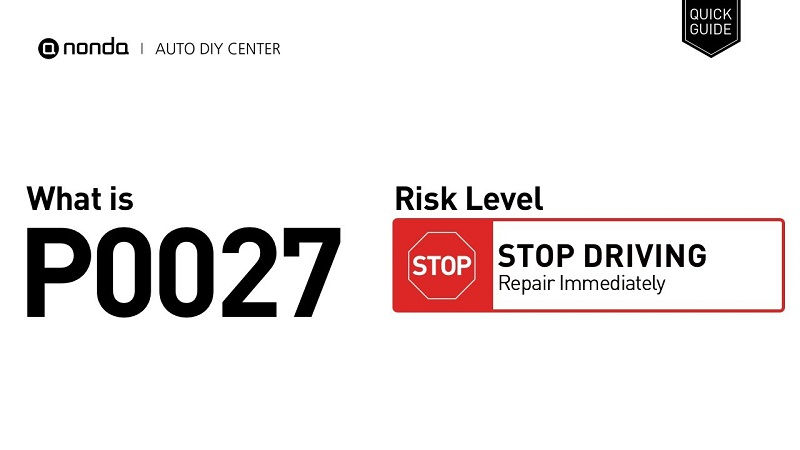This post contains affiliate links. This means I will make a commission at no extra cost to you should you click through and make a purchase [ “As an Amazon Associate, I earn from qualifying purchases.” ]. Read the full disclosure here.
Decoding the P0027 Code: Exhaust Valve Control Solenoid Circuit Range/Performance Bank 1 GuideMechanic.Com In the intricate world of automotive diagnostics, the sudden appearance of a check engine light often signifies a journey into the inner workings of a vehicle’s engine.
Among the plethora of diagnostic trouble codes (DTCs) that can trigger this warning, the P0027 code is a notable contender.
This code, indicating an issue with the Exhaust Valve Control Solenoid Circuit Range/Performance in Bank 1, can present a perplexing challenge for both drivers and mechanics.
In this comprehensive article, we’ll delve into the intricacies of the P0027 code, exploring its significance, potential causes, symptoms, and methods of resolution.
See Also: P0025 Code “B” Camshaft Position – Timing Over-Retarded (Bank 2)
P0027 Code Exhaust Valve Control solenoid Circuit Range/Performance Bank 1
Unveiling the Basics

The P0027 code is an integral part of the On-Board Diagnostics II (OBD-II) system, a standardized protocol adopted in vehicles since the 1990s.
Designed to monitor various components and systems within the vehicle, the OBD-II system serves as an invaluable tool for detecting potential malfunctions.
Specifically, P0027 pertains to the exhaust valve control solenoid circuit, signaling an issue with the range or performance within Bank 1 of the engine.
Recognizing Symptoms
When the P0027 code surfaces, drivers may notice a variety of symptoms, ranging from subtle to pronounced. These symptoms may include:
- Check Engine Light Activation: The most apparent indication of trouble is the illumination of the check engine light on the vehicle’s dashboard.
- Decreased Engine Performance: The engine may exhibit diminished power, sluggish acceleration, or reduced fuel efficiency due to improper operation of the exhaust valve control solenoid.
- Rough Idling or Stalling: Unstable idling or stalling may occur, particularly when the vehicle is stationary or operating at low speeds.
- Engine Misfires: Misfires, characterized by the failure of one or more cylinders to ignite fuel properly, may become more frequent.
Potential Causes
Several factors can contribute to the activation of the P0027 code. These potential causes include:
- Faulty Exhaust Valve Control Solenoid: A malfunctioning solenoid can disrupt the operation of the exhaust valve control system, leading to performance issues.
- Electrical Circuit Problems: Wiring harness issues, connector damage, or corrosion can interfere with the electrical signals sent to the exhaust valve control solenoid.
- Engine Oil Contamination: Contaminated engine oil or debris in the oil passages can impede the proper functioning of the solenoid, affecting performance.
- Mechanical Component Failure: Damage or wear to mechanical components, such as the camshaft, can disrupt the exhaust valve control system.
- ECM Software Glitches: In rare cases, software bugs or glitches in the engine control module (ECM) may trigger erroneous fault codes like P0027.
P0027 Code Exhaust Valve Control solenoid Circuit Range/Performance Bank 1
Diagnosis and Resolution
Diagnosing and resolving a P0027 code typically involves a systematic approach, often encompassing the following steps:
- Code Reading: Utilize an OBD-II scanner to retrieve the stored trouble codes, including P0027, from the vehicle’s ECM.
- Visual Inspection: Conduct a visual inspection of the engine bay, searching for visible signs of damage or leaks, particularly around the exhaust valve control solenoid and associated components.
- Electrical Testing: Test the electrical circuits associated with the exhaust valve control solenoid using a multimeter to ensure proper voltage and continuity.
- Solenoid Testing: Test the exhaust valve control solenoid for proper operation, checking for responsiveness and continuity.
- Oil System Inspection: Inspect the engine oil and oil passages for contamination or blockages, ensuring proper lubrication of the exhaust valve control components.
- Mechanical Component Inspection: If necessary, conduct a thorough inspection of mechanical components, such as the camshaft, for signs of damage or wear.
- Software Update: Consider updating the ECM software to the latest version provided by the manufacturer if all other potential causes are ruled out.
Seeking Professional Assistance
While some automotive enthusiasts may attempt to diagnose and resolve P0027 issues independently, others may prefer to enlist the expertise of a qualified automotive technician.
These professionals possess the knowledge, tools, and resources necessary to accurately diagnose and address complex engine problems.
P0027 Code Exhaust Valve Control solenoid Circuit Range/Performance Bank 1
Conclusion
See Also: P0026 Code Intake Valve Control Solenoid Circuit Range/Performance Bank 1
The P0027 code, indicating an issue with the Exhaust Valve Control Solenoid Circuit Range/Performance in Bank 1, can present a formidable challenge for vehicle owners.
However, armed with a basic understanding of its causes and symptoms, as well as the diagnostic and resolution process, drivers can approach this problem with confidence.
Whether tackling it themselves or seeking professional assistance, addressing the underlying issues causing the P0027 code is essential to restoring the vehicle’s performance and reliability.
- How to Fix P007E Code: A Comprehensive Guide - May 21, 2024
- P007D Code: Charge Air Cooler Temperature Sensor Circuit High Bank 1 - May 20, 2024
- P007C Code: Charge Air Cooler Temperature Sensor Circuit Low Bank 1 - May 19, 2024



